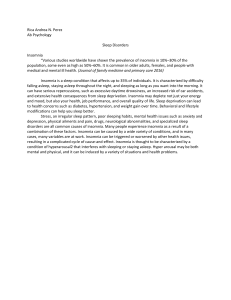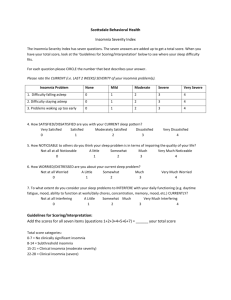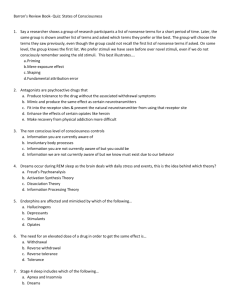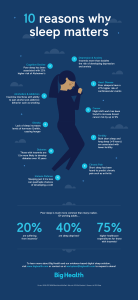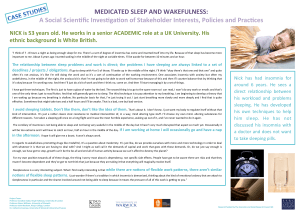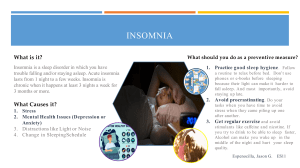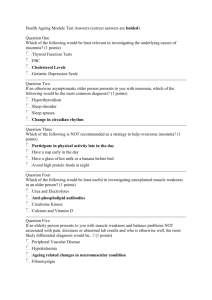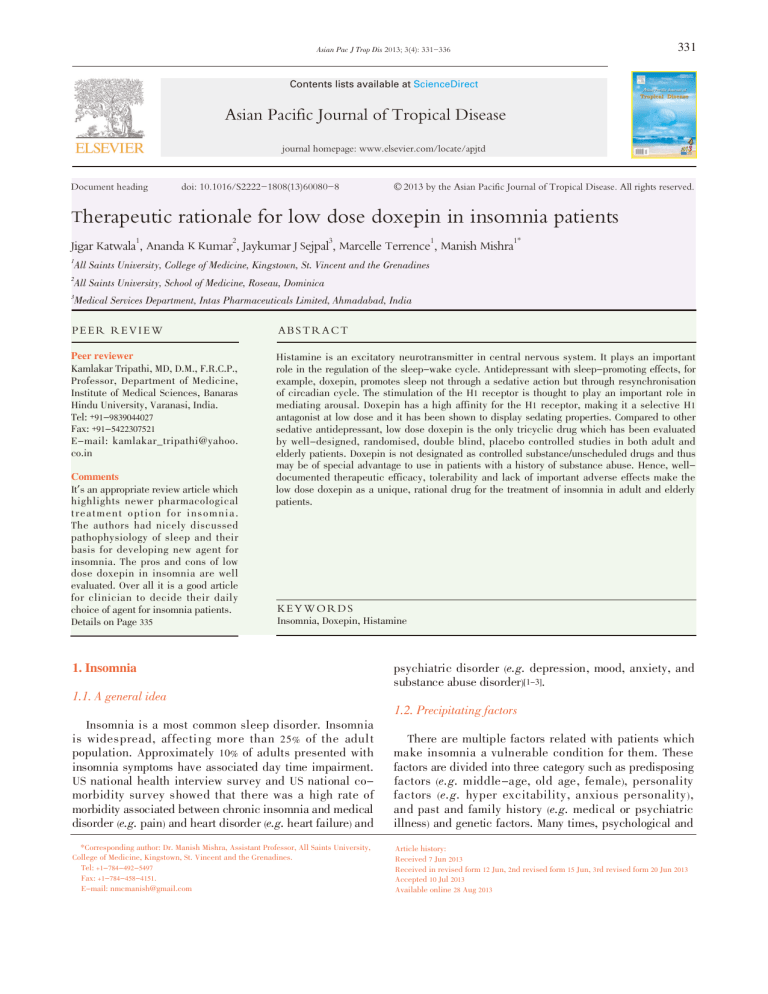
331 Asian Pac J Trop Dis 2013; 3(4): 331-336 Contents lists available at ScienceDirect Asian Pacific Journal of Tropical Disease journal homepage: www.elsevier.com/locate/apjtd Document heading doi: 10.1016/S2222-1808(13)60080-8 Therapeutic rationale for low dose doxepin in insomnia patients 1 2 襃 2013 by the Asian Pacific Journal of Tropical Disease. All rights reserved. 3 1 1* Jigar Katwala , Ananda K Kumar , Jaykumar J Sejpal , Marcelle Terrence , Manish Mishra All Saints University, College of Medicine, Kingstown, St. Vincent and the Grenadines 1 All Saints University, School of Medicine, Roseau, Dominica 2 Medical Services Department, Intas Pharmaceuticals Limited, Ahmadabad, India 3 PEER REVIEW ABSTRACT Peer reviewer Kamlakar Tripathi, MD, D.M., F.R.C.P., P rofessor, D epartment of M edicine, Institute of Medical Sciences, Banaras Hindu University, Varanasi, India. Tel: +91-9839044027 Fax: +91-5422307521 E -mail: kamlakar_tripathi@yahoo. Histamine is an excitatory neurotransmitter in central nervous system. It plays an important role in the regulation of the sleep-wake cycle. Antidepressant with sleep-promoting effects, for co.in Comments It’s an appropriate review article which highlights newer pharmacological treatment option for insomnia. T he authors had nicely discussed pathophysiology of sleep and their basis for developing new agent for insomnia. The pros and cons of low dose doxepin in insomnia are well evaluated. Over all it is a good article for clinician to decide their daily choice of agent for insomnia patients. Details on Page 335 example, doxepin, promotes sleep not through a sedative action but through resynchronisation of circadian cycle. The stimulation of the H1 receptor is thought to play an important role in mediating arousal. Doxepin has a high affinity for the H1 receptor, making it a selective H1 antagonist at low dose and it has been shown to display sedating properties. Compared to other sedative antidepressant, low dose doxepin is the only tricyclic drug which has been evaluated by well-designed, randomised, double blind, placebo controlled studies in both adult and elderly patients. Doxepin is not designated as controlled substance/unscheduled drugs and thus may be of special advantage to use in patients with a history of substance abuse. Hence, welldocumented therapeutic efficacy, tolerability and lack of important adverse effects make the low dose doxepin as a unique, rational drug for the treatment of insomnia in adult and elderly patients. KEYWORDS Insomnia, Doxepin, Histamine 1. Insomnia 1.1. A general idea Insomnia is a most common sleep disorder. Insomnia is widespread, affecting more than 25 % of the adult population. Approximately 10% of adults presented with insomnia symptoms have associated day time impairment. US national health interview survey and US national comorbidity survey showed that there was a high rate of morbidity associated between chronic insomnia and medical disorder (e.g. pain) and heart disorder (e.g. heart failure) and *Corresponding author: Dr. Manish Mishra, Assistant Professor, All Saints University, College of Medicine, Kingstown, St. Vincent and the Grenadines. Tel: +1-784-492-5497 Fax: +1-784-458-4151. E-mail: nmcmanish@gmail.com psychiatric disorder (e.g. depression, mood, anxiety, and substance abuse disorder)[1-3]. 1.2. Precipitating factors There are multiple factors related with patients which make insomnia a vulnerable condition for them. These factors are divided into three category such as predisposing factors (e.g. middle-age, old age, female), personality factors ( e.g. hyper excitability, anxious personality ) , and past and family history (e.g. medical or psychiatric illness) and genetic factors. Many times, psychological and Article history: Received 7 Jun 2013 Received in revised form 12 Jun, 2nd revised form 15 Jun, 3rd revised form 20 Jun 2013 Accepted 10 Jul 2013 Available online 28 Aug 2013 332 Jigar Katwala et al./Asian Pac J Trop Dis 2013; 3(4): 331-336 behavioural factors also worsen insomnia (e.g. unexpected loss of loved one, loss of job)[1,4-8]. 2. Classification of insomnia Insomnia has been classified as two ways: by the duration of the insomnia or by its etiology. B ased on duration, insomnia is classified as transient insomnia (lasting no longer than 7 d), short-term insomnia (lasting for less than 3 weeks), and chronic insomnia. Transient and short-term insomnias are common during emotional distress. Chronic insomnia lasts for longer duration of usually more than 3 weeks, and some even more than 30 d. The other category of insomnia is based on etiology which includes primary insomnia (occurring without any specific physical and mental conditions) and secondary insomnia (associated with other medical and psychiatric illness, medications, or other sleep disorders)[8,9]. T he I nternational C lassification of S leep D isorder (ICSD) has categorized insomnia as adjustment insomnia, behavioural insomnia of childhood, idiopathic, paradoxical, psychophysiological, and inadequate sleep hygiene, insomnia due to drug or substance, medical condition or mental disorder[10]. 3. Symptoms and definition Various working groups on sleep disorder such as The I nternational S tatistical C lassification of D iseases and Related Health Problems 10th Revision (ICD-10), Diagnostic and Statistical Manual of Mental Disorders (DSM-IV-TR) and ICSD-2, agree on three main diagnostic criteria to define insomnia. These three chief complaints include difficulty initiating sleep, difficulty maintaining sleep, and waking up too early. Patient has a poor quality or non-restorative sleep. A consequent impairment in daytime functioning and associated subjective symptoms such as fatigue, daytime sleepiness, low energy level, mood irritability, difficulties in cognitive activity (e.g. concentration, memory and attention), lack of motivation, constant worry for sleep and tension headache[10-12]. 4. Definition According to the DSM-IV-TR diagnostic criteria for primary insomnia requires[12]: (i) A predominant complaint of difficulty in initiating or maintaining sleep, or nonrestorative sleep, for at least one month. (ii) The sleep disturbance (or associated daytime fatigue) causes clinically significant distress or impairment in social, occupational, or other important areas of functioning. (iii) The sleep disturbance does not occur exclusively during the course of another sleep disorder (narcolepsy, breathing-related sleep disorder, etc). (iv) The disturbance is not due to the direct physiological effects of a substance (e.g. a drug of abuse, a medication) or another psychiatric or general medical condition. 5. Currently available treatments for insomnia T he B ritish A ssociation for P sychopharmacology guidelines recommended that it is extremely necessary to treat insomnia because the condition causing poor quality of life, is associated with impaired functioning in many areas, and leads to increased risk of psychological disorder (e.g. depression, anxiety) and possibly cardiovascular disorders. M ain goals of insomnia treatment are to produce less suffering and to improve daytime function[4]. T here are various methods of psychological and behavioural intervention for treatment of insomnia, including the sleep hygiene, stimulus control, sleep restriction, relaxation techniques, feedback, cognitive therapy, “chronotherapy”, and phytotherapy[5]. The British Association for Psychopharmacology Consensus, American A cademy of S leep M edicine, and the 2005 US N ational Institute of Health State-of Science Conference on insomnia concluded that cognitive behavioural therapy (CBT) and benzodiazepine receptor agonist have level a evidence for short-term treatment of chronic insomnia. CBT is effective for individual or a group of people [4,6,13]. T he current mainstay for the pharmacotherapy of insomnia is as below[49,13,14]: 1 . E n h a n c i n g t h e i n hi bi t o ry w a ke - pr omot i ng neurotransmitter gamma amino benzoic acid (GABA). A . B enzodiazepine receptors agonist: triazolam, temazepam, lorazepam, and flurazepam. B . N on-benzodiazepine receptor agonist ( Z -drug ) : zolpidem, zaleplon, eszopiclone. 2. Melatonin, ramelteon, almorexant. 3. Other agents. A. Over the counter (OTC) products: diphenhydramine hydrochloride, diphenhydramine citrate, doxylamine succinate. B. Tricyclic anti-depressant agents (TCAs): amitriptyline, nortriptyline, doxepin, trazodone. 6. Limitations of current therapies 6.1. Benzodiazepines and non-benzodiazepines agents These hypnotic agents act by enhancing sleep promoting neurotransmitter (GABA). It causes high degree of inhibition of arousal. Therefore, the wake-promoting systems mediated via norepinephrine, acetylcholine, histamine, dopamine and serotonin are inhibited by GABA mechanisms. There is a balance between these two systems for safe functioning, such as driving, walking to the bathroom in dark without falling[9]. These compounds have reported efficacy and safety in terms of improvement in sleep quality. However, they are associated with numerous adverse events such as daytime sedation or next-day residual effects, motor incoordinataion, reduced psychomotor performance, cognitive impairment and related concerns about increases in risk of motor vehicle accidents and injuries from fall[9,14]. Chronic administration of benzodiazepines agonists agent produces tolerance, psychological dependence. The adaptive changes in GABA receptor cause withdrawal, characterized 333 Jigar Katwala et al./Asian Pac J Trop Dis 2013; 3(4): 331-336 by neurological, physical and cognitive symptoms, and rebound insomnia[4,9,14,15]. These agents have also been associated with the potential for abuse and dependence in at risk populations, which led the US Drug Enforcement Agency to classify them as Schedule IV substances[16,17]. 6.2. Melatonin, ramelteon and almorexant Newer approaches include ramelteon, the first and only nonscheduled drug approved by the US FDA for the treatment of insomnia, and in the future possibly by the orexin system, through agents such as almorexant. Ramelteon produces sleep through activation of melatonin 1 and melatonin 2 receptors in the suprachiasmatic nucleus of the hypothalamus. Almorexant produces selective antagonism of orexin OX1 and OX2 receptor. There is no adequate evidence that they are effective in the treatment of insomnia[15,18]. 6.3. Other agents Anti-histaminics are the active ingredients of OTC sleep aids available in market (i.e. diphenhydramine, doxylamine). D isadvantages of the current OTC antihistamines are their relatively long duration of action and next-morning drowsiness, potential side effects, and insufficient receptor selectivity has risk of undesired anticholinergic side effect (i.e. dry mouth, dry eye, retention of urine, constipation)[16]. The most commonly used anti-depressants for co-morbid insomnia include sedating tricyclics anti-depressants (TCAs), such as amitriptyline, doxepin, and nortriptyline, and 5HT2 antagonist trazodone. They are effective for inducing sleep and improving sleep continuity. The TCAs can alter sleep architecture by reducing rapid eye movement (REM) sleep. In general, sedating properties of anti-depressant agents are related to antagonism of serotonin 5HT2, histamines, and α-1 adrenergic receptors[14-16]. Because of their non-selective antagonist action on 5HT2, histamines, and α-1 adrenergic receptors, these agents produce side effects such as anticholinergic, adrenergic blockade, and prolong cardiac conduction. These agents also cause potential side effects such as weight gain, increased suicidal ideation, hypomania or mania in patients with bipolar disorder. There is short of evidence which proves that sedative anti-depressants are effective in the treatment of insomnia. Although due to lack of abuse potential, they are considered as unscheduled drug. They are cheaper and well studied drugs. Therefore, they are drug of choice for patients with co-morbid insomnia who is suffering from depression. Although, the treatment of insomnia is widely used, many agents that block the histamine H1 receptor are considered to have therapeutic limitations, including the development of next-day carryover sedation, as well as problems with chronic use, such as the development of tolerance to sedative-hypnotic action and weight gain. TCAs like doxepin exert such potent histamine H1 blockade that it has been possible to optimize their hypnotic activity by using very low dose. Since March 2010, the US FDA has approved low dose doxepin for the indication of insomnia[19]. In this review, we have discussed the further details of role of histamine for wakefulness and blockade of histamine by doxepin to reduce the wakefulness. Effectiveness and safety of doxepin for the patients who have complaint of sleep maintenance and sleep onset insomnia. 7. Emerging trends R ecent research has revisited one of the oldest approaches to insomnia, namely by using anti-depressant and antihistaminic properties. A nti-histaminic such as diphenhydramine and doxylamine are used as sleep promoting agents. They are available as over the counter products. Anti-depressants with histamine antagonist action such as trazodon, doxepin, mirtazapine and antipsychotic with antihistaminic properties like quetiapine are used for the treatment of insomnia with co-morbid psychiatric condition like depression[14,15]. 7.1. Arousal pathway Histamine is the key neurotransmitter for arousal. It is synthesized in the hypothalamus. It drives the wakefulness known as “wake-promoting” neurotransmitter. The major site of histaminic neurones is tuberomammillary nucleus (TMN). The distribution of histamine receptors in brain is very dense. Histamine H1 receptors are of high density in the cortex and in the limbic system, while histamine H2 receptors have high density in the striatum, cerebral cortex, and also in the limbic system; and finally, histamine H3 receptors, the autoreceptors, are dense in the striatum and the cortex. Histamine produces its action via direct and indirect stimulation of arousal pathway. Direct pathway causes stimulation of histamine receptor travelling via the ascending histaminergic neurones from hypothalamus to thalamic H 1 and H 2 receptors or in the cortex via histamine H1 receptor. The release of histamine causes calm wakefulness (i.e. well-rested state, the ability to focus on cognitive task, problem solving, learning, creativity). S econdly, histamine also produces indirect activation of basal forebrain cholinergic neurone via histamine H1 receptors. This stimulation causes release of acetylcholine which stimulated arousal ( i.e. anxiety, fright, external vigilance) (Figure 1)[14,15,20-22]. Low dose doxepin acting as anti hisaminic causes H1 receptors blockade in TMN. Benzodiazepines Thalamus Hypothalamus Z-drugs vPAG BF (ACh, GABA) (DA) TMN Rapne (His) (5-HT) LDT (ACh) Medulla VLPO SCN PPT (ACh) Melatonin/derivatives LC (NA) Pons DMH Caffeine LH TMN VTA vPAG DRN Antidepressants Amphetamine Modafinil LC A1/A2 Cerebellum Brainstem Figure 1. Arousal pathway and mechanism of action of hypnotic drugs. A mong anti-depressants, doxepin has the highest binding capacity to histamine receptors. Its potency to bind histamine is even stronger than classical antihistaminic. Doxepin had high binding to histamine in frontal cortex, 334 Jigar Katwala et al./Asian Pac J Trop Dis 2013; 3(4): 331-336 amygdale, temporal cortex, and the hippocampus[20]. Low dose doxepin acts via blocking H1 receptors, which is very unique among the currently approved FDA drugs for the treatment of insomnia. Doxepin, 3 mg and 6 mg, were approved by USFDA in March, 2010 in both adult and elderly patients suffering from short and long term insomnia[19]. 8. Low dose doxepin for insomnia Doxepin is a three-decade old tricyclic anti-depressant agent. I t is approved for the treatment of depression, depression with insomnia and anxiety disorders. Antidepressant action produces with ≥25 mg of doxepin. Lower dosage produces anti-anxiety effect. A nti-depressant action of doxepin is because of reuptake inhibition of norepinephrine and serotonin. Higher dose ≥25 mg of doxepin is nonslective and responsible for undesired side effects such as anticholinergic, antiadrenergic, and potentiation of cardiac conduction (Figure 2)[23,24]. Doxepin Hydrochloride C19H21NO·HCl CH N CH3 CH3 ·HCI O Figure 2. Chemical structure of doxepin hydrochloride. Lower dose doxepin has a very high selectivity for H1 receptor. It binds with histamine receptors for 100 times more than that of nor-epinephrine and serotonin receptors. Antagonism of histamine receptors in TMN nucleus inhibits the arousal pathway. This produces hypnotic action. Thus low dose of doxepin (1, 3, 6 mg) can produce selective H1 blockade[19,20,23,24,]. Low dose doxepin is advantages for the patients with complaint of objective and subjective measures of sleep maintenance and sleep onset insomnia. S leep effects seem to be dose dependent, and among the very lowdose preparations being studied, the 3 mg and 6 mg doses appeared the most effective in adult as well as elderly patients; doxepin (Silenor@) has been approved for insomnia treatment in USA[19]. 9. Clinical efficacy and safety of 1, 3, and 6 mg doxepin in insomnia 9.1. Efficacy Doxepin 1, 3, and 6 mg is widely studied in both adult and elderly patients with difficulty in sleep onset and sleep maintenance insomnia. There were 1 423 subjects, with chronic insomnia (n=858) or transient (n=565) insomnia participated in 6 randomised, double-blind studied. These studies were up to 3 months in duration and included patients of both sex between 18 and 93 years of age. Compared to placebo, all three Doxepin doses, 1, 3, and 6 mg produced significant improvement in sleep parameters such as wake time after sleep onset, total sleep time and sleep efficiency. T hese improvements were sustained throughout the duration of studies[19,25-30]. In the 3-month clinical trial, the 3 mg dose produces significant improvement in sleep latency without evidence of next-day residual sedation[27]. In elderly patients, the 4-week study of 6 mg doxepin significantly improved total sleep time and sleep quality versus placebo and these improvements were sustained throughout the trial[25]. Clinical trial in transient insomnia patients (n=565) also demonstrated the effectiveness of doxepin 6 mg in sleep onset, sleep maintenance, sleep duration and sleep quality[28]. Thus doxepin is useful for both sleep maintenance and sleep onset or difficulty in falling sleep. It decreases the frequent waking at night and increase the total duration of sleep. 9.2. Tolerability Low dose doxepin had an incidence of adverse effects compared to placebo. There were no reported anticholinergic effects, no memory impairment and no evidence of next day residual effects. Doxepin should be avoided in patients who take anti-depresants, alcohol and sedating antihistaminic. Doxepin is metabolized by CYP isoenzymes, co-administration of cimetidine and sertraline like CYP inhibitors may increase the plasma concentration of doxepin[19,25-30]. 9.3. Safety Low dose doxepin is safe drug for short term and long term insomnia. Low dose doxepin is different from other antidepressants in three effects. First, low dose doxepin has no reports of suicide in clinical trial. Therefore, low dose doxepin does not have a boxed warning for suicide risk. Second, doxepin is not associated with abuse potential in animals or in human. Third, there is no report of weight gaining or appetite increasing. The most common adverse reactions reported were sedation, somnolence, nausea and upper respiratory tract infection[19,25-30]. During the clinical trial, there is no report for rebound insomnia/withdrawal syndrome after doxepin discontinuation. Thus doxepin does not produce physical dependence[19,25-30]. Cardiac safety study showed no prolongation of QT interval with 50 mg dose of doxepin[31]. Doxepin is pregnancy category C drug. It is not a controlled substance like benzodiazepine drugs. In the elderly population and patients with hepatic insufficiency, 3 mg of starting dose is recommended. Mild renal impairment does not required dose adjustment. It should be avoided in patients with severe urinary retention, narrow angle glaucoma and who are currently taking monoamine oxidase inhibitors or has used MAOI for the past two weeks. The uncontrolled insomnia after 7-10 days of treatment may indicate possibility of secondary insomnia or co-morbid insomnia[19]. 9.4. Dose administration Doxepin dosage is very simple for insomnia patients. It is available in strength of 3 mg and 6 mg immediate release oral tablet. The recommended dose of doxepin for adults is Jigar Katwala et al./Asian Pac J Trop Dis 2013; 3(4): 331-336 6 mg once daily. The starting dose for the elderly patients >65 years old is 3 mg once daily. The daily dose can be increased to 6 mg, if clinically required. It should be taken within 30 min of bedtime. To minimize the potential for next day effects, doxepin should not be taken within 3 h of a meal[19]. 10. Benefits of low dose doxepin therapy for insomnia Low doses doxepin 3 mg and 6 mg have several distinctive advantages over other available hypnotic agents for several reasons[19,25-30]. 1. It does not directly interfere with the other arousal systems[14,15,20]. 2 . T he finding of trials confirmed that doxepin 3 mg and 6 mg is efficacious in improving sleep latency, sleep maintenance and sleep quality. M oreover, these improvements are sustained for long duration of 3 months. 3 . I t does not cause daytime sedation ( no next-day sedation). 4. Published clinical trials demonstrated that it is effective in adult as well as elderly patients with primary insomnia and current data suggest that it is also safe and well tolerated at 6 mg dose[19,25,27,29]. 5 . N o incidence of withdrawal syndrome or rebound insomnia after discontinuing doxepin 3 mg or 6 mg[25-27]. 6. Use of low dose doxepin is not associated with tolerance, and anti-cholinergic side effect. Further, it is not associated with weight gain and cardiac re-polarization[19,25-30]. 7. It is a non-controlled substance that enjoys virtually no risk of addiction or dependence[19]. This allows easier prescribing with fewer prescribing restrictions, as well as being potentially effective in high-risk patient populations (e.g. history of alcohol or drug abuse) and those who require a pharmacologic agent on a more chronic basis. 11. Conclusion In conclusion, doxepin at low doses of 3 mg and 6 mg is effective and well tolerated. It is also safe and nonhabit forming option for patients with insomnia. Doxepin is not a controlled substance and it has no risk of abuse. Unlike GABA agonists, low dose doxepin selectively blocks histaminergic action and its arousal property resulting in natural sleep. Low dose doxepin is a new armamentarium for managing chronic primary insomnia and transient insomnia characterized by difficulties with sleep maintenance in adult and elderly patients. Conflict of interest statement We declare that we have no conflict of interest. Comments Background Insomnia is an iceberg disease. Prevalence of insomnia 335 is high among the adults as well as the elders. Majority of time, primary insomnia patients are unidentified, as the patients are ignorant to the sleep problems and avoid to visit the physicians. Insomnia is characterized by difficulty in initiating or maintaining sleep. Insomnia is associated with nonrestorative sleep and daytime fatigue, malaise, irritability and decreased memory and concentration. Morbidity of insomnia patients increased when they have associated comorbid condition such as depression, psychosis and cardiac disease. Traditional hypnotic medications, benzodiazepines and nonbenzodiazepines, act via GABA inhibitory pathway in brain and they are associated with adverse events such as abuse potential, withdrawal syndrome on discontinuation of medication and rebound insomnia. They also developed tolerance and dependence. While, TCAs and anti-depressant agents have proven their effectiveness in improvement of sleep onset and sleep maintenance in healthy subjects as well as depressant patients even after long term use. During the clinical studies, these agents had low abuse potential and dependence. An old TCAs, doxepin, approved to treat depression and anxiety disorder. It also effectively cures insomnia patients with depression. Its potent H1 receptors blocking action is useful for sleep disorder. L ow dose doxepin has open new frontier to treat primary insomnia and chronic insomnia patients. Doxepin in 3 mg and 6 mg doses was approved by USFDA in 2010 to treat sleep onset and sleep maintenance in adult and elderly with chronic insomnia. Research frontiers T he review highlights new and important aspects of insomnia treatment. The authors performed a good review for the role of histamine receptors and their blockade with doxepin to treat insomnia. This approach is a novel compare to traditional therapy. T his article focuses on recent developments in insomnia treatment and will be helpful for physician to decide their preferential hypnotic to treat insomnia patients. Related reports Z isapel, L oachimescu et al. and S ullivan recently discussed the emerging drugs for insomnia. They reported the advantage of unique action of doxepin when used in 3 mg and 6 mg. In this review, the authors also concluded that low dose doxepin is effective and safe in primary insomnia patients. They also discussed detailed pathophysiology of insomnia and described potential of histamine pathway to induce sleep, which was not the part of previously published articles of the other authors. Innovations & breakthroughs This review adds additional support to the use of low dose doxepin in primary insomnia. The authors had wisely covered pathophysiology and clinical data of low dose doxepin. It is a good article for physician for quick guide to hypnotic. Applications This review provides a glimpse on recent developments in insomnia treatment and it will be definitely helpful for physician to decide their preferential medication to treat insomnia patients. 336 Jigar Katwala et al./Asian Pac J Trop Dis 2013; 3(4): 331-336 Peer review It is an appropriate review article which highlights newer pharmacological treatment option for insomnia. The authors had nicely discussed pathophysiology of sleep and their basis for developing new agent for insomnia. The pros and cons of low dose doxepin in insomnia are well evaluated. Over all it is a good article for clinician to decide their daily choice of agent for insomnia patients. References [1] Morin M, Benca R. Chronic insomnia. Lancet 2012; 379: 1129-1141. [2] Roth T, Jaeger S, Jin R, Kalsekar A, Stang PE, Kessler RC. Sleep problems, comorbid mental disorders, and role functioning in the national comorbidity survey replication. Biol Psychiatry 2006; 60: 1364-1371. [3] Pearson NJ, Johnson LL, Nahin RL. Insomnia, trouble sleeping, and complementary and alternative medicine: analysis of the 2002 national health interview survey data. Arch Intern Med 2006; 166: 1775-1782. [4] Wilson SJ, Nutt DJ, Alford C, Argyropoulos SV, Baldwin DS, Bateson AN, et al. British association for psychopharmacology consensus statement on evidence-based treatment of insomnia, parasomnias and circadian rhythm disorders. J Psychopharmacol 2010; 24: 1577-1600. [5] Schutte-Rodin S, Broch L, Buysse D, Dorsey C, Sateia M. Clinical guideline for the evaluation and management of chronic insomnia in adults. J Clin Sleep Med 2008; 4: 487-504. [6] Morgenthaler T, Kramer M, Alessi C, Friedman L, Boehlecke B, Brown T, et al. Practice parameters for the psychological and behavioral treatment of insomnia: an update. Sleep 2006; 29: 14151419. [7] Pigeon WR. Diagnosis, prevalence, pathways, consequences & treatment of insomnia. Indian J Med Res 2010; 131: 321-332. [8] G alimi R . I nsomnia in the elderly: an update and future challenges. G Gerontol 2010; 58: 231-247. [9] Charles AC, Winkelman JW, Richardson GS. Sleep disorders. In: Kasper DL, Braunwald E, Fauci AS, Hauser SL, Longo DL, Jameson JL, Editors. Harrison’s internal medicine. 17th ed. New York: McGraw-Hill Publishing; 2005, p. 153-161. [10] American Academy of Sleep Medicine. International classification of sleep disorders: diagnostic and coding manual. 2 nd ed. Westchester: American Academy of Sleep Medicine, 2005. [11] World Health Organization. The ICD-10 classification of mental and behavioral disorders: Clinical descriptions and diagnostic guidelines[R]. Geneva: WHO, 1992. [12] American Psychiatric Association. Diagnostic and statistical manual of mental disorders. 4 th ed. W ashington DC : T he American Psychiatric Association, 2000. [13] Morgan K, Kucharczyk E, Gregory P. Insomnia: evidence-based approaches to assessment and management. Clin Med 2011; 11: 278-281. [14] Stahl SM. Selective histamine H1 antagonism: novel hypnotic and pharmacologic actions challenge classical notions of antihistamines. CNS Spectr 2008; 13: 1027-1038. [15] Owen RT. Selective histamine H (1) antagonism: A novel approach to insomnia using low-dose doxepin. Drugs Today (Barc) 2009; 45: 261-267. [16] Pinto Jr LR, Alves RC, Caixeta E, Fontenelle JA, Bacellar A, Poyares D, et al. New guidelines for diagnosis and treatment of insomnia. Arq Neuropsiquiatr 2010; 68: 666-675. [17] Zammit G. Comparative tolerability of newer agents for insomnia. Drug Saf 2009; 32: 735-748. [18] M ets MA , van D eventer KR , O livier B , V erster JC . C ritical appraisal of ramelteon in the treatment of insomnia. Nat Sci Sleep 2010; 2: 257-266. [19] S omaxon P harmaceuticals I nc. H ighlights of prescribing information. San Diego: Somaxon Pharmaceuticals Inc.; 2010. [Online] Available from: http://www.silenor.com/pub/download. ashx?key=%2fwECFQ%3d%3d [Accessed on 25th April, 2013] [20] Elliott R. Neurobiology of the histamine system - A key regulator of sleep-wake function. [Online] Available from: http://www. medscape.org/viewarticle/585181 [Accessed on 25th April, 2013] [21] S lats D , C laassen JA , V erbeek MM , O vereem S . R eciprocal interactions between sleep, circadian rhythms and Alzheimer’s disease: focus on the role of hypocretin and melatonin. Ageing Res Rev 2013; 12: 188-200. [22] M itchell HA , W einshenker D . G ood night and good luck: norepinephrine in sleep pharmacology. Biochem Pharmacol 2010; 79: 801-809. [23] Goforth HW. Low-dose doxepin for the treatment of insomnia: emerging data. Expert Opin Pharmacother 2009; 10: 1649-1655. [24] Markov D, Doghramji K. Doxepin for insomnia. Curr Psychiatry 2010; 9: 67-77. [25] Lankford A, Rogowski R, Essink B, Ludington E, Heith Durrence H, Roth T. Efficacy and safety of doxepin 6 mg in a four-week outpatient trial of elderly adults with chronic primary insomnia. Sleep Med 2012; 13: 133-138. [26] Krystal AD, Lankford A, Durrence HH, Ludington E, Jochelson P, Rogowski R, et al. Efficacy and safety of doxepin 3 and 6 mg in a 35-day sleep laboratory trial in adults with chronic primary insomnia. Sleep 2011; 34: 1433-1442. [27] Krystal AD, Durrence HH, Scharf M, Jochelson P, Rogowski R, Ludington E, et al. Efficacy and safety of doxepin 1 mg and 3 mg in a 12-week sleep laboratory and outpatient trial of elderly subjects with chronic primary insomnia. Sleep 2010; 33: 1553-1561. [28] Roth T, Heith Durrence H, Jochelson P, Peterson G, Ludington E, Rogowski R, et al. Efficacy and safety of doxepin 6 mg in a model of transient insomnia. Sleep Med 2010; 11: 843-847. [29] Scharf M, Rogowski R, Hull S, Cohn M, Mayleben D, Feldman N, et al. Efficacy and safety of doxepin 1 mg, 3 mg, and 6 mg in elderly patients with primary insomnia: a randomized, doubleblind, placebocontrolled crossover study. J Clin Psychiatry 2008; 69: 1557-1564. [30] Roth T, Rogowski R, Hull S, Schwartz H, Koshorek G, Corser B, et al. Efficacy and safety of doxepin 1 mg, 3 mg, and 6 mg in adults with primary insomnia. Sleep 2007; 30: 1555-1561. [31] Mansbach RS, Ludington E, Rogowski R, Kittrelle JP, Jochelson P. A placebo- and active-controlled assessment of 6- and 50-mg oral doxepin on cardiac repolarization in healthy volunteers: A thorough QT evaluation. Clin Ther 2011; 33: 851-862.
